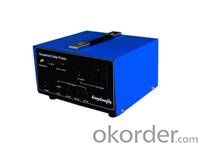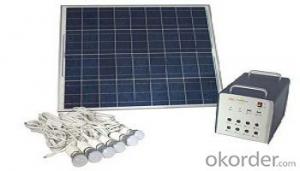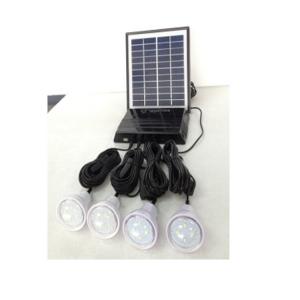Best Residential Solar Energy Systems - SPK_300_LED Solar Power System Hot Selling
- Loading Port:
- China main port
- Payment Terms:
- TT or LC
- Min Order Qty:
- 3 pc
- Supply Capability:
- 10000 pc/month
OKorder Service Pledge
OKorder Financial Service
You Might Also Like
Main Information
KDF SPK_300_LED This product is high performance,family used portable solar power system,which can receive energy and store it in battery outside connected to SPK by solar energy on sunny day,and supplies electric power for varies appliances such as electric fan,lighting lamps, television, portable computer etc.It can supply power for both DC and AC electric application.It’s very helpful and useful for home electric supply.

Features:
◆ Battery puts outside connected to the SPK for user to choose battery in recommended range, and easily to exchange battery.
◆ Both DC and AC output
◆ Solar Feedback Circuit Protection
◆ Output Short-circuit Protection
◆ Solar「+」「-」anti-access protection
◆ Output「+」「-」anti-access protection
◆ Over Charged Protection
◆ Over Discharged Protection
◆ Over Load Protection
◆ Over-Temperature Protection
Technical parameters
Specification | Value/Material | |
Item No. KDF | SPK_300_LED | |
Solar Recommended | Specification | Poly silicon |
Working Voltage/Power | 18V80W~120W | |
Battery Recommended | Rated Voltage/Capacity | 12V65AH~100AH |
Specification | Lead Acid | |
Charging Controller | Operating Voltage | 12V |
Input Voltage | 17.3V~21V | |
Input current | MAX:10A | |
Power Consumption | MAX: 5mA | |
Low Voltage Disconnect(LVD) | 10.8V | |
Low Voltage Reconnect(LVR) | 12.3V | |
High Voltage Discharge( HVC) | 14.6V | |
High Voltage Recharge(HVR) | 13.8V | |
Temperature Protection | 60℃ | |
DC Output | DC output & Application | USB 5V2A |
DC output & Application | DC 12V1*3A | |
AC Output | Output Wave | modified sine wave |
Input Voltage | 11V~15V | |
Output Voltage | 110V±10% | |
Output Frequency | 60Hz±2Hz/50Hz±2Hz | |
Rated Output Power | 300W | |
Maximum VA | 600VA | |
Maximum Efficiency | 88% | |
Temperature | 0-40℃ | |
Over Temperature | 60℃~70℃ | |
Low Voltage Alarm | 11V | |
Low Voltage Shut off | 10.5V | |
High Voltage Shut off | 16V | |
Package | Set size | 278*240*172mm |
Set N·W | 2.8kg | |
Set N·W | 3.6kg | |
- Q: How do solar energy systems contribute to reducing carbon emissions?
- Solar energy systems contribute to reducing carbon emissions in several ways. Firstly, solar energy is a renewable and clean source of power. Solar panels harness sunlight and convert it into electricity without any emissions of greenhouse gases. This means that when solar energy is used to generate electricity, it does not release carbon dioxide or any other harmful pollutants into the atmosphere, unlike traditional fossil fuel power plants. Secondly, solar energy can replace the use of fossil fuels in various sectors. For example, solar panels can be installed on residential rooftops to provide electricity for homes, reducing the need for electricity generated from coal or natural gas. Similarly, solar farms can be established to produce large-scale solar power for commercial and industrial purposes. By displacing the use of fossil fuels, solar energy systems help to lower carbon emissions associated with electricity generation. Moreover, solar energy can also be used for heating purposes. Solar thermal systems can capture and utilize the sun's heat to provide hot water for residential and commercial buildings. By utilizing solar thermal systems, the demand for gas or electricity to heat water is reduced, resulting in a decrease in carbon emissions from water heating processes. Furthermore, the widespread adoption of solar energy systems can lead to a decrease in the overall demand for fossil fuels. As more households, businesses, and industries switch to solar power, the demand for coal, oil, and natural gas decreases. This reduced demand for fossil fuels can drive down their production and consumption, resulting in a significant reduction in carbon emissions associated with extracting, refining, and burning these fuels. In summary, solar energy systems contribute to reducing carbon emissions by producing clean and renewable electricity, replacing the use of fossil fuels, reducing the demand for traditional energy sources, and providing an alternative for heating purposes. By transitioning to solar power, we can significantly mitigate the impact of climate change and work towards a more sustainable future.
- Q: Can solar energy systems be used in areas with limited access to solar energy warranties and guarantees?
- Yes, solar energy systems can still be used in areas with limited access to solar energy warranties and guarantees. While warranties and guarantees provide added assurance and protection, the viability of solar energy systems in such areas depends on factors like local climate conditions, available sunlight, and the efficiency of the system. Proper design, installation, and maintenance can help optimize energy production, making solar energy systems feasible even without extensive warranty coverage. Additionally, alternative financing options and community initiatives can help mitigate potential risks and barriers in areas with limited access to solar energy warranties and guarantees.
- Q: Can solar energy systems be integrated with battery storage?
- Yes, solar energy systems can be integrated with battery storage. Battery storage allows excess energy generated from solar panels to be stored and used during times when the sun is not shining, such as at night or during cloudy days. This integration helps provide a continuous and reliable source of electricity, reducing reliance on the grid and maximizing the benefits of solar energy.
- Q: Are there any risks of electrical fires with solar energy systems?
- Solar energy systems, although generally regarded as safe, do pose potential risks of electrical fires. The improper installation or maintenance of the system stands as one of the primary hazards. Inadequate wiring or faulty electrical connections can result in overheating and fire hazards. Moreover, insufficient grounding of solar panels or system faults can also heighten the likelihood of electrical fires. Hence, it is vital to enlist the services of qualified professionals for both installation and regular maintenance of solar energy systems, effectively minimizing these risks. To further diminish the chances of electrical fires, it is crucial to adhere to fire safety measures, including the use of appropriate wiring, the installation of proper fire detection and suppression systems, and ensuring sufficient ventilation surrounding the solar panels. Consequently, despite solar energy systems generally being safe, it is imperative to acknowledge these risks and implement necessary precautions to mitigate them.
- Q: How does solar energy impact job creation?
- Solar energy impacts job creation by creating a significant number of employment opportunities in various sectors such as manufacturing, installation, maintenance, and research and development. The growth of the solar energy industry has led to the creation of numerous jobs, both in the renewable energy sector and related industries. This includes positions for engineers, technicians, project managers, salespeople, and more. Additionally, as solar energy becomes more affordable and widely adopted, it stimulates economic growth and encourages investments, further boosting job creation in local communities.
- Q: Can solar energy systems be used for powering telecommunications towers or antennas?
- Certainly, solar energy systems are capable of powering telecommunications towers and antennas. Solar power presents a sustainable and dependable energy source that can be harnessed to supply electricity for various purposes, including the operation of telecommunications infrastructure. To function efficiently, telecommunications towers and antennas require a steady and uninterrupted flow of electricity. However, conventional methods of powering these structures, like diesel generators, not only incur high expenses but also contribute to pollution and carbon emissions. Solar energy systems, on the other hand, offer a cleaner and more economical alternative. By installing solar panels on or near the telecommunications tower, sunlight is captured and transformed into electricity through photovoltaic cells. This electricity can be utilized directly to power the tower's equipment or stored in batteries for use during periods of low sunlight. Through the adoption of solar energy, telecommunication companies can reduce their reliance on fossil fuels and decrease operational costs. Furthermore, solar energy systems can be implemented in remote areas where accessing the grid or establishing a reliable power supply can be challenging. In such instances, solar power can provide a viable solution, enabling telecommunication companies to expand coverage and connectivity to underserved regions. In conclusion, solar energy systems prove to be an exceptional option for powering telecommunications towers and antennas. They present a sustainable and cost-effective solution while minimizing environmental impact. With advancements in solar technology, the efficiency and reliability of solar power systems continue to improve, establishing them as a viable choice for the telecommunications industry.
- Q: How does the presence of birds or other wildlife affect the performance of solar panels?
- The presence of birds or other wildlife can potentially affect the performance of solar panels in several ways. One of the main concerns is the possibility of bird droppings on the surface of the solar panels. Bird droppings can create a layer of dirt and debris, reducing the amount of sunlight that reaches the solar cells. This can lead to a decrease in the efficiency of the panels and a decline in their overall performance. Another issue is the risk of bird nests or other wildlife habitats being built near or on the solar panel systems. These nests can obstruct the sunlight from reaching the panels, causing a drop in energy production. Additionally, nests can potentially damage the panels or their mounting structures if they are built in close proximity. Furthermore, larger birds like raptors or pigeons may occasionally perch on the solar panels, causing physical damage to the panels or the wiring. This can lead to malfunctions or reduced electrical output. To mitigate these potential issues, there are several solutions available. One common approach is the use of deterrents such as bird spikes, netting, or scare devices to prevent birds from landing or nesting on the panels. Regular cleaning and maintenance of the panels are also important to remove any bird droppings or debris that may accumulate. Additionally, designing solar panel systems with bird-friendly features in mind can help minimize the impact on wildlife. For example, incorporating gaps or spaces between panels can discourage birds from nesting, while still allowing sufficient airflow for cooling. In conclusion, while the presence of birds or other wildlife can pose challenges for solar panels, implementing preventive measures and maintenance practices can help ensure optimal performance and longevity of the system.
- Q: Can solar energy systems be used in areas with high seismic activity?
- Yes, solar energy systems can be used in areas with high seismic activity. However, it is essential to design and engineer these systems to withstand seismic forces. This can be achieved by utilizing specialized mounting structures, such as ballasted or anchored systems, and ensuring proper installation and maintenance. Additionally, advanced technologies like micro-inverters or power optimizers can enhance the system's resilience by minimizing the impact of potential module shading or damage caused by seismic events. Overall, with proper planning and precautions, solar energy systems can be successfully implemented in areas prone to high seismic activity.
- Q: Can solar energy be used in cloudy climates?
- Yes, solar energy can still be used in cloudy climates. While the efficiency of solar panels may be slightly reduced in overcast conditions, they can still generate electricity. Additionally, advancements in technology, such as the use of bifacial solar panels, have made it possible to capture sunlight from multiple angles, allowing solar energy to be harnessed even in cloudy weather.
- Q: Are there any risks of electromagnetic radiation with solar energy systems?
- Yes, there are minimal risks of electromagnetic radiation with solar energy systems. Solar panels generate direct current (DC) electricity, which does not emit electromagnetic fields (EMF) or radiation. However, some components of solar energy systems, such as inverters or power conditioning units, convert DC electricity to alternating current (AC), and may produce low levels of EMF. These levels are typically well below the safety limits set by regulatory bodies and pose no significant health risks to humans.
Send your message to us
Best Residential Solar Energy Systems - SPK_300_LED Solar Power System Hot Selling
- Loading Port:
- China main port
- Payment Terms:
- TT or LC
- Min Order Qty:
- 3 pc
- Supply Capability:
- 10000 pc/month
OKorder Service Pledge
OKorder Financial Service
Similar products
Hot products
Hot Searches
Related keywords



























